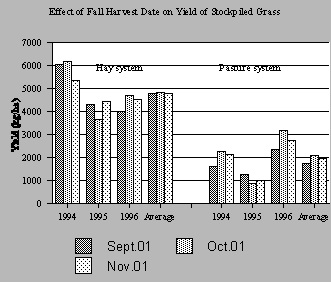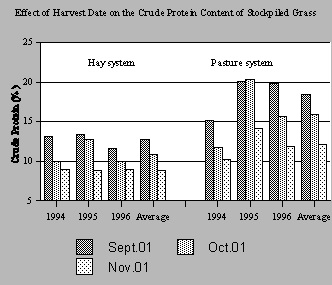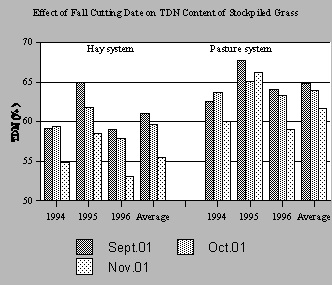Stockpiled pasture: effect of harvest date on the yield and quality of stockpiled grass
Learn the effects of harvest date on yield and quality of stockpiled grass. Stockpiling is the practice of allowing certain hay or pasture fields to regrow during mid-summer or early fall so they are available for grazing later in the season.
Introduction
Stockpiling is the practice of allowing certain hay or pasture fields to regrow during mid-summer or early fall so they are available for grazing later in the season. Stockpile grazing is also known as deferred grazing or fall-saved pasture. The primary reason for using stockpiled pasture is to save on feed costs. In this report, we discuss the effect of three harvest dates in late summer and fall on the yield and quality of stockpiled grass.
This study was established in 1993 in research plots. Stockpiled forages were harvested from 1994 to 1996. The grasses were stockpiled using two distinct management systems: the hay management system consisted of a single harvest in early July followed by stockpiling until the fall harvests; the pasture system consisted of a harvest in mid-June, another harvest in late July, followed by stockpiling until the fall harvests. Thus, the hay system had only 1 cut (early July) prior to stockpiling, while the pasture system had two cuts (mid-June and mid-July) prior to stockpiling.
Under each management system, sufficient plots were established to allow a cut of stockpiled forage to be taken either September 1, October 1, or November 1. At each of these dates, the yield and quality of the forage was measured. While several grass species were evaluated, the data reported below is the average of all grass species. Data examining differences between species is included in a separate report.
Results
Yield
Overall, the yield of stockpiled grass in fall was higher under the hay management system as compared to the pasture management system (Figure 1). In 1994 and 1996, the yield increased from September to October, then decreased by November. This trend occurred in both the hay and pasture management systems.
An increase from September to October would be expected since killing frosts do not normally occur until mid-September at this site and growth is still occurring. A decrease in grass yield during October would also be expected since some hard frosts occur at that time but rainy weather is also common. This combination would tend to break down grass leaves and leach out some of the soluble portions, which would in turn reduce the yield. In 1995, the opposite trend occurred, with yields decreasing from September to October, then increasing by November. While the reason for this is not clear, it seems likely that dry weather in late summer reduced yields but the grass recovered later in the year when soil moisture increased.
Quality — Protein
Overall, the crude protein content of stockpiled grass was higher under the pasture management system than under the hay management system (Figure 2).
In both systems, crude protein was highest in September, intermediate in October, and lowest in November. The pattern of decline in crude protein varied over years. In 1994, protein levels dropped sharply between September and October, while in 1995 protein was almost unchanged between September and October, but dropped sharply between the October and November harvests. The decline in protein was about equal over the three harvest periods in 1996. Overall, crude protein levels dropped by about 30% from September 01 to November 01. It is worth noting however that protein levels under the hay system averaged about 9% in November. This is sufficient to maintain non-lactating cows or ewes.
Quality — Total Digestible Nutrients
Total digestible nutrients (TDN) is a measure of the energy content of a feed. In forage samples, TDN is calculated from the acid detergent fibre (ADF) value.
Overall, TDN levels were higher in grasses stockpiled using the pasture management system as compared to the hay management system (Figure 3). Under the hay system, TDN values dropped sharply between the October and November harvests, although the total decline in TDN values was only about 8% from September to November. Under the pasture system, TDN dropped between October and November in 2 of 3 years. Averaged over all three years, TDN declined by about 5% from September to November. When the absolute values are considered, it is apparent that the stockpiled forage still had quite high energy levels in November. The lowest recorded average (53%) should be quite sufficient for dry beef cows that are in good body condition provided the weather is not extremely harsh. Stockpiled forage with higher TDN values (59% to 67%) are sufficient for putting condition on cows, grazing weaned lambs, or breeding ewes.
Summary and interpretation
In 2 years of 3, stockpiled forage yield increased between September and October, then declined in November. In the majority of years at this location, this is the expected trend. The amount of dry matter yield lost during October was between 5 and 15% of the maximum yield. The increase in dry matter yield during September tended to be greater under the pasture system, since this forage was younger and in a more active growth stage than the forage in the hay system.
In almost all cases, protein and energy (TDN) values decline from September to November. The rate of decline in protein varied over years, but the decline in energy values tended to be most apparent between the October and November harvests. The percent decline in protein content was high (about 30% below September 01 values); but the decline in energy was much lower (5 to 8% below September 01 values).
Managing the stockpiling process will vary depending on the type of livestock being pastured and the nutritional requirements of the livestock. The general decline in yield and quality as fall progresses cannot be changed, but through stockpiling management, the producer can affect the yield and quality that will be present at any given fall date. Livestock that will have low requirements in October and November (i.e. dry beef cows) can be grazed under the hay system described above. Where higher nutrient requirements occur (i.e. calves, breeding ewes), the pasture management system can be used to ensure higher quality forage is available. To maintain a more consistent quality of forage as fall progresses, a hay system stockpile could be grazed in October, then the livestock switched to a pasture system stockpile in November. Since each situation will vary, it is the job of the pasture manager to determine what combination of pasture yield and quality will be needed during the fall and to manage the stockpiling process to achieve those targets.


